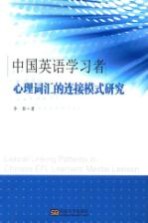

中国英语学习者心理词汇的连接模式研究PDF电子书下载
- 电子书积分:12 积分如何计算积分?
- 作 者:李黎著
- 出 版 社:南京:东南大学出版社
- 出版年份:2016
- ISBN:7564168162
- 页数:315 页
CHAPTER ONE INTRODUCTION 1
1.1 Needs for the research 1
1.2 Significance of the research 2
1.2.1 Theoretical significance 3
1.2.2 Methodological significance 5
1.2.3 Pedagogical significance 6
1.3 Organization of the book 7
CHAPTER TWO A LITERATURE REVIEW 8
2.1 Introduction 8
2.2 Definitions of key terms 8
2.2.1 Mental lexicon 8
2.2.2 Representation and processing 10
2.2.3 Priming 10
2.2.4 Reaction time(RT) 12
2.2.5 Lexical variables 13
2.2.5.1 Word frequency 13
2.2.5.2 Concreteness 14
2.2.6 Language effect 16
2.3 Theories and studies on the L1 mental lexicon 17
2.3.1 Theories on the L1 mental lexicon 17
2.3.2 Theories on lexical-conceptual organization in the L1 mental lexi-con 22
2.3.3 Lexical-conceptual studies on the L1 mental lexicon 24
2.3.3.1 General lexical-conceptual organization of L1 mental lexicon 25
2.3.3.2 Lexical-conceptual organization related to lexical variables effects 32
2.4 Theories and studies on the L2 mental lexicon 36
2.4.1 Theories on the L2 mental lexicon 37
2.4.1.1 Weinreich's Model 37
2.4.1.2 Distributed Conceptual Feature Model(DCFM) 38
2.4.1.3 The Revised Hierarchical Model(RHM) 39
2.4.1.4 Three-stage Hypothesis 42
2.4.1.5 BIA 43
2.4.1.6 Parasitic Hypothesis 45
2.4.1.7 The Sense Model 45
2.4.2 Lexical-conceptual studies on the L2 mental lexicon 47
2.4.2.1 Lexical variable effects on L2 lexical-conceptual organization 49
2.4.2.2 Language effects on L2 lexical-conceptual organization 54
2.4.2.3 Proficiency effects on L2 lexical-conceptual organization 76
2.5 Limitations of the previous studies 82
2.5.1 Theoretical limitations 83
2.5.1.1 Diverse understandings to the way in which L2 words are linked to L1 83
2.5.1.2 Diverse understandings to the way in which L1 words are linked to L2 84
2.5.1.3 Scarce theories and RT studies with translation recognition for L2 lexical variable effects 85
2.5.1.4 Diverse understandings towards the proficiency effect 87
2.5.1.5 Inadequate exploration on Chinese EFL leaners 88
2.5.2 Methodological limitations 92
2.6 Summary 94
CHAPTER THREE METHODOLOGY 95
3.1 Research questions 95
3.2 Research description 97
3.3 Experiment design and rationale 97
3.3.1 Experiment design 97
3.3.2 The rationale 98
3.4 Participants and methods 99
3.4.1 Participants 99
3.4.2 Materials and instruments 100
3.4.2.1 Materials 103
3.4.2.2 The Latin square design 106
3.4.2.3 E-Prime 107
3.4.3 Tasks and procedures 107
3.4.4 Data analysis 110
3.4.4.1 Data collection 110
3.4.4.2 Data processing 110
3.4.4.3 SPSS analysis 111
3.5 Summary 112
CHAPTER FOUR REPRESENTATION AND PROCESSING OF BILIN-GUAL MENTAL LEXICON:LEXICAL VARIABLE EFFECTS 113
4.1 Frequency effect 114
4.1.1 Overall frequency effects 115
4.1.2 Frequency effect on orthographic level 117
4.1.3 Frequency effect on semantic level 118
4.1.3.1 Frequency effect on translation equivalent 118
4.1.3.2 Frequency effect on meaning distracter 121
4.1.4 Differences in frequency effects between L2-L1 and L1-L2 links 124
4.1.5 Form/meaning influence on frequency 126
4.1.6 Summary 129
4.2 Concreteness effect 129
4.2.1 Overall concreteness effects 129
4.2.2 Concreteness effect on orthographic level 133
4.2.3 Concreteness effect on semantic level 135
4.2.3.1 Concreteness effect on translation equivalent 135
4.2.3.2 Concreteness effect on meaning distracter 137
4.2.4 Differences in concreteness effects between L2-L1 and L1-L2 links 139
4.2.5 Form/meaning influence on concreteness 140
4.2.6 Summary 143
4.3 A model of lexical variable effects on form/meaning links 144
CHAPTER FIVE REPRESENTATION AND PROCESSING OF BILIN-GUAL MENTAL LEXICON:LANGUAGE EFFECTS 151
5.1 L2-L1 links 152
5.1.1 Orthographic level 152
5.1.2 Semantic level 153
5.1.2.1 Translation priming effect 154
5.1.2.2 Meaning interference effect 157
5.1.3 Difference between orthographic and semantic level in L2-L1 link 159
5.2 L1-L2 links 160
5.2.1 Orthographic level 160
5.2.2 Semantic level 161
5.2.2.1 Translation priming effect 162
5.2.2.2 Meaning interference effect 163
5.2.3 Difference between orthographic and semantic level in L1-L2 link 165
5.3 Difference between L2-L1 and L1-L2 links 166
5.3.1 Accuracy 166
5.3.2 Overall RT patterns 167
5.3.3 Difference at the orthographic level 168
5.3.4 Difference at the semantic level 170
5.4 A model of language effects 172
CHAPTER SIX REPRESENTATION AND PROCESSING OF BILINGUAL MENTAL LEXICON:PROFICIENCY EFFECTS 178
6.1 Overall proficiency effect on accuracy and RT patterns 178
6.2 Proficiency effects on orthographic/semantic levels 181
6.2.1 Overall proficiency effects on orthographic/semantic levels 181
6.2.2 Proficiency effect on orthographic level 184
6.2.3 Proficiency effect on semantic level 187
6.2 3.1 Proficiency effect on translation equivalent 187
6.2.3.2 Proficiency effect on meaning distracter 194
6.2.4 Summary 203
6.3 Proficiency effect on lexical variables 204
6.3.1 Proficiency effect on frequency 209
6.3.2 Proficiency effect on concreteness 212
6.3.3 Summary 215
6.4 Proficiency effect on L2-L1 and L1-L2 links 215
6.5 A Bilingual Form/Meaning Linking(BFML)model 219
CHAPTER SEVEN CONCLUSION 228
7.1 Major findings on the bilingual mental lexicon 228
7.1.1 Lexical variable effects on L2 word organization 228
7.1.2 Language effects on L2 word organization 229
7.1.3 Proficiency effects on L2 word organization 229
7.2 Implications of the findings 231
7.2.1 Theoretical implications 231
7.2.1.1 Establishing a Bilingual Form/Meaning Linking(BFML)model 231
7.2.1.2 Highlighting lexical(form)vs.conceptual(meaning)representa-tion aud processing of Chinese EFL learners 233
7.2.1.3 Providing more evidence for the existing models 236
7.2.2 Methodological implications 237
7.2.2.1 Applying RT experiment paradigm to L2 word acquisition research 237
7.2.2.2 Applying translation recognition task to RT study 239
7.2.2.3 Creating a stimulus word pair list 240
7.2.3 Pedagogical implications 241
7.2.3.1 Establishing and refining L2 concept 241
7.2.3.2 Teaching and learning L2 vocabulary 243
7.2.3.3 Pedagogical possibilities into psycholinguistic reality 247
7.3 Limitations of the study 248
7.4 Recommendations for future research 250
7.5 Summary 251
REFERENCES 252
APPENDIXES 273
Appendix 1 273
Appendix 2 277
Appendix 3 281
Appendix 4 284
Appendix 5 286
Appendix 6 292
Appendix 7:MATERIALS 294
Version 1 294
Version 2 300
Version 3 305
Version 4 310
ABBREVIATIONS 315
- 《汉语词汇知识与习得研究》邢红兵主编 2019
- 《法语词汇认知联想记忆法》刘莲编著 2020
- 《《国语》和《战国策》词汇比较研究》陈长书著 2017
- 《党员干部理论学习培训教材 理论热点问题党员干部学习辅导》(中国)胡磊 2018
- 《大学生心理健康与人生发展》王琳责任编辑;(中国)肖宇 2019
- 《深度学习与飞桨PaddlePaddle Fluid实战》于祥 2019
- 《教师教育系列教材 心理学原理与应用 第2版 视频版》郑红,倪嘉波,刘亨荣编;陈冬梅责编 2020
- 《阅读与心理健康》王波主编 2019
- 《全国普通高等中医药院校药学类专业“十三五”规划教材 第二轮规划教材 有机化学学习指导 第2版》赵骏 2018
- 《高中英语词汇考试指导》徐志江编著 2019
